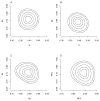A hybrid Bayesian hierarchical model combining cohort and case-control studies for meta-analysis of diagnostic tests: Accounting for partial verification bias
- PMID: 24862512
- PMCID: PMC4245380
- DOI: 10.1177/0962280214536703
A hybrid Bayesian hierarchical model combining cohort and case-control studies for meta-analysis of diagnostic tests: Accounting for partial verification bias
Abstract
To account for between-study heterogeneity in meta-analysis of diagnostic accuracy studies, bivariate random effects models have been recommended to jointly model the sensitivities and specificities. As study design and population vary, the definition of disease status or severity could differ across studies. Consequently, sensitivity and specificity may be correlated with disease prevalence. To account for this dependence, a trivariate random effects model had been proposed. However, the proposed approach can only include cohort studies with information estimating study-specific disease prevalence. In addition, some diagnostic accuracy studies only select a subset of samples to be verified by the reference test. It is known that ignoring unverified subjects may lead to partial verification bias in the estimation of prevalence, sensitivities, and specificities in a single study. However, the impact of this bias on a meta-analysis has not been investigated. In this paper, we propose a novel hybrid Bayesian hierarchical model combining cohort and case-control studies and correcting partial verification bias at the same time. We investigate the performance of the proposed methods through a set of simulation studies. Two case studies on assessing the diagnostic accuracy of gadolinium-enhanced magnetic resonance imaging in detecting lymph node metastases and of adrenal fluorine-18 fluorodeoxyglucose positron emission tomography in characterizing adrenal masses are presented.
Keywords: Bayesian method; cohort and case–control studies; diagnostic test; meta-analysis; partial verification bias.
© The Author(s) 2014.
Figures



Similar articles
-
Meta-analysis of diagnostic accuracy studies accounting for disease prevalence: alternative parameterizations and model selection.Stat Med. 2009 Aug 15;28(18):2384-99. doi: 10.1002/sim.3627. Stat Med. 2009. PMID: 19499551
-
Hybrid copula mixed models for combining case-control and cohort studies in meta-analysis of diagnostic tests.Stat Methods Med Res. 2018 Aug;27(8):2540-2553. doi: 10.1177/0962280216682376. Epub 2016 Dec 21. Stat Methods Med Res. 2018. PMID: 29984634
-
Adjusting for partial verification or workup bias in meta-analyses of diagnostic accuracy studies.Am J Epidemiol. 2012 Apr 15;175(8):847-53. doi: 10.1093/aje/kwr383. Epub 2012 Mar 15. Am J Epidemiol. 2012. PMID: 22422923
-
Statistical methods for multivariate meta-analysis of diagnostic tests: An overview and tutorial.Stat Methods Med Res. 2016 Aug;25(4):1596-619. doi: 10.1177/0962280213492588. Epub 2013 Jun 26. Stat Methods Med Res. 2016. PMID: 23804970 Free PMC article. Review.
-
PET/CT and MRI for Identifying Axillary Lymph Node Metastases in Breast Cancer Patients: Systematic Review and Meta-Analysis.J Magn Reson Imaging. 2020 Dec;52(6):1840-1851. doi: 10.1002/jmri.27246. Epub 2020 Jun 21. J Magn Reson Imaging. 2020. PMID: 32567090
Cited by
-
A Bayesian hierarchical model for network meta-analysis of multiple diagnostic tests.Biostatistics. 2018 Jan 1;19(1):87-102. doi: 10.1093/biostatistics/kxx025. Biostatistics. 2018. PMID: 28586407 Free PMC article.
-
Global identifiability of latent class models with applications to diagnostic test accuracy studies: A Gröbner basis approach.Biometrics. 2020 Mar;76(1):98-108. doi: 10.1111/biom.13133. Epub 2019 Nov 6. Biometrics. 2020. PMID: 31444807 Free PMC article.
-
Meta-Analysis Methods of Diagnostic Test Accuracy Studies.Methods Mol Biol. 2022;2345:173-185. doi: 10.1007/978-1-0716-1566-9_11. Methods Mol Biol. 2022. PMID: 34550591
References
-
- Pepe MS. The statistical evaluation of medical tests for classification and prediction. Oxford University Press; 2003.
-
- Zhou XH, Obuchowski NA, McClish DK. Wiley Series in Probability and Statistics. 2011. Statistical methods in diagnostic medicine.
-
- Li J, Fine JP, Safdar N. Prevalence-dependent diagnostic accuracy measures. Statistics in Medicine. 2007;26(17):3258–3273. - PubMed
-
- Song F, Khan KS, Dinnes J, Sutton AJ. Asymmetric funnel plots and publication bias in meta-analyses of diagnostic accuracy. International Journal of Epidemiology. 2002;31(1):88–95. - PubMed
-
- Macaskill P. Empirical Bayes estimates generated in a hierarchical summary ROC analysis agreed closely with those of a full Bayesian analysis. Journal of Clinical Epidemiology. 2004;57(9):925–932. - PubMed
MeSH terms
Grants and funding
LinkOut - more resources
Full Text Sources
Other Literature Sources
Medical
Molecular Biology Databases
Research Materials

